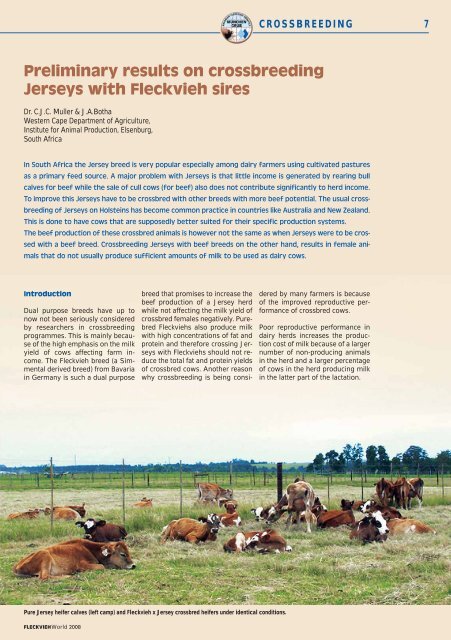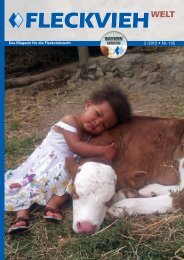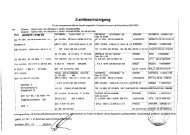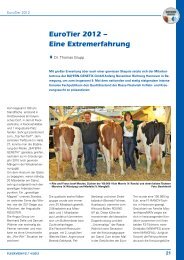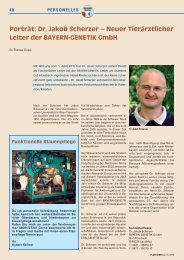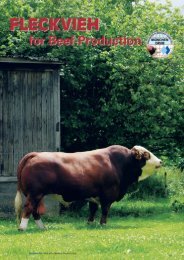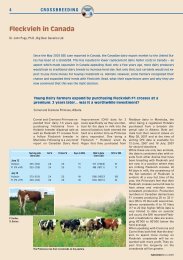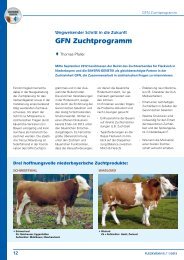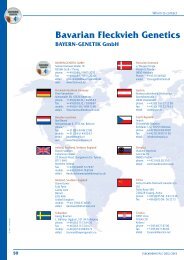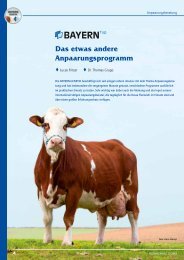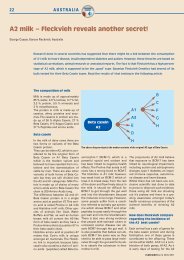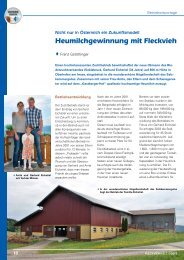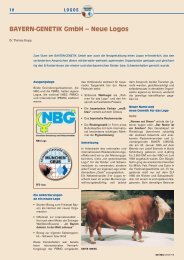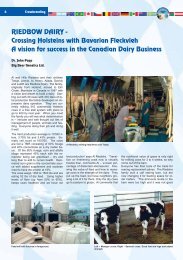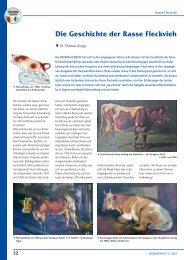Preliminary results on crossbreeding Jerseys with Fleckvieh sires
Preliminary results on crossbreeding Jerseys with Fleckvieh sires
Preliminary results on crossbreeding Jerseys with Fleckvieh sires
Create successful ePaper yourself
Turn your PDF publications into a flip-book with our unique Google optimized e-Paper software.
<str<strong>on</strong>g>Preliminary</str<strong>on</strong>g> <str<strong>on</strong>g>results</str<strong>on</strong>g> <strong>on</strong> <strong>crossbreeding</strong><br />
<strong>Jerseys</strong> <strong>with</strong> <strong>Fleckvieh</strong> <strong>sires</strong><br />
Dr. C.J.C. Muller & J.A.Botha<br />
Western Cape Department of Agriculture,<br />
Institute for Animal Producti<strong>on</strong>, Elsenburg,<br />
South Africa<br />
Introducti<strong>on</strong><br />
Dual purpose breeds have up to<br />
now not been seriously c<strong>on</strong>sidered<br />
by researchers in <strong>crossbreeding</strong><br />
programmes. This is mainly because<br />
of the high emphasis <strong>on</strong> the milk<br />
yield of cows affecting farm income.<br />
The <strong>Fleckvieh</strong> breed (a Simmental<br />
derived breed) from Bavaria<br />
in Germany is such a dual purpose<br />
Pure Jersey heifer calves (left camp) and <strong>Fleckvieh</strong> x Jersey crossbred heifers under identical c<strong>on</strong>diti<strong>on</strong>s.<br />
FLECKVIEHWorld 2008<br />
breed that promises to increase the<br />
beef producti<strong>on</strong> of a Jersey herd<br />
while not affecting the milk yield of<br />
crossbred females negatively. Purebred<br />
<strong>Fleckvieh</strong>s also produce milk<br />
<strong>with</strong> high c<strong>on</strong>centrati<strong>on</strong>s of fat and<br />
protein and therefore crossing <strong>Jerseys</strong><br />
<strong>with</strong> <strong>Fleckvieh</strong>s should not reduce<br />
the total fat and protein yields<br />
of crossbred cows. Another reas<strong>on</strong><br />
why <strong>crossbreeding</strong> is being c<strong>on</strong>si-<br />
CROSSBREEDING 7<br />
In South Africa the Jersey breed is very popular especially am<strong>on</strong>g dairy farmers using cultivated pastures<br />
as a primary feed source. A major problem <strong>with</strong> <strong>Jerseys</strong> is that little income is generated by rearing bull<br />
calves for beef while the sale of cull cows (for beef) also does not c<strong>on</strong>tribute significantly to herd income.<br />
To improve this <strong>Jerseys</strong> have to be crossbred <strong>with</strong> other breeds <strong>with</strong> more beef potential. The usual <strong>crossbreeding</strong><br />
of <strong>Jerseys</strong> <strong>on</strong> Holsteins has become comm<strong>on</strong> practice in countries like Australia and New Zealand.<br />
This is d<strong>on</strong>e to have cows that are supposedly better suited for their specific producti<strong>on</strong> systems.<br />
The beef producti<strong>on</strong> of these crossbred animals is however not the same as when <strong>Jerseys</strong> were to be crossed<br />
<strong>with</strong> a beef breed. Crossbreeding <strong>Jerseys</strong> <strong>with</strong> beef breeds <strong>on</strong> the other hand, <str<strong>on</strong>g>results</str<strong>on</strong>g> in female animals<br />
that do not usually produce sufficient amounts of milk to be used as dairy cows.<br />
dered by many farmers is because<br />
of the improved reproductive performance<br />
of crossbred cows.<br />
Poor reproductive performance in<br />
dairy herds increases the producti<strong>on</strong><br />
cost of milk because of a larger<br />
number of n<strong>on</strong>-producing animals<br />
in the herd and a larger percentage<br />
of cows in the herd producing milk<br />
in the latter part of the lactati<strong>on</strong>.
8 CROSSBREEDING<br />
Little informati<strong>on</strong> is available in<br />
South Africa <strong>on</strong> the effect of <strong>crossbreeding</strong><br />
dairy cows. Most <strong>crossbreeding</strong><br />
trials in other countries<br />
have been c<strong>on</strong>ducted <strong>with</strong> Holsteins<br />
while <strong>Jerseys</strong> have received<br />
little attenti<strong>on</strong> being a breed <strong>with</strong><br />
relatively small numbers. The objective<br />
of this study is to compare<br />
the total income (milk and beef producti<strong>on</strong>)<br />
of Jersey and <strong>Fleckvieh</strong> x<br />
Jersey cows in an intensive feeding<br />
system.<br />
Materials and Methods<br />
The study is being c<strong>on</strong>ducted at<br />
the Elsenburg Research Stati<strong>on</strong> of<br />
the Western Cape Department of<br />
Agriculture. Elsenburg is situated<br />
approximately 50 km east of Cape<br />
Town at an altitude of 177m, l<strong>on</strong>gitude<br />
18° 50’ and latitude 33° 51’<br />
and is in the winter rainfall regi<strong>on</strong><br />
of South Africa. The area is characterised<br />
by cool wet winters and<br />
l<strong>on</strong>g dry summers. The Jersey<br />
herd at Elsenburg was divided into<br />
two groups according to age<br />
and estimated breeding value for<br />
milk yield. Groups were allocated<br />
randomly to two treatments, i.e.<br />
breeding <strong>with</strong> (i) Jersey or (ii)<br />
<strong>Fleckvieh</strong> <strong>sires</strong>. In the following<br />
breeding period, treatments will<br />
be switched and female animals<br />
All feed intake is measured at the research<br />
facilities<br />
Table 1:<br />
The number and growth performance of all bull and<br />
heifer calves born from <strong>Fleckvieh</strong> and Jersey <strong>sires</strong><br />
in the Elsenburg Jersey herd<br />
Sire used<br />
Parameters Jersey <strong>Fleckvieh</strong><br />
Number of cows calving down 31 32<br />
Live weight of dams before calving (kg) 452 457<br />
Number of calves born alive 28 26<br />
Birth weight of calves (kg) 26.4 31.9<br />
Number of calves at last weighing 24 26<br />
Age at last weighing (days) 190 154<br />
Live weight at last weighing (kg) 124.7 125.4<br />
Average daiy gain (kg) 0.435 0.557<br />
Calculated live weight at 6 m of age (kg) 106.5 133.5<br />
will be inseminated <strong>with</strong> <strong>sires</strong><br />
from the other breed.<br />
All pure- and crossbred bull and<br />
heifers calves born from these<br />
matings in the herd are being reared<br />
in the same way. Heifers are<br />
reared to calve down at approximately<br />
24 m<strong>on</strong>ths of age while<br />
bull calves are reared to be marketed<br />
at either six or 24 m<strong>on</strong>ths of<br />
age. The bull calves marketed at<br />
six m<strong>on</strong>ths of age are being reared<br />
intensively for veal producti<strong>on</strong>.<br />
Bull calves reared for beef<br />
are castrated <strong>with</strong> a Burdizzo at<br />
about three m<strong>on</strong>ths of age and<br />
reared <strong>on</strong> pasture from six<br />
m<strong>on</strong>ths of age. They receive a<br />
c<strong>on</strong>centrate supplementati<strong>on</strong> of<br />
2 kg per animal per day up to<br />
12 m<strong>on</strong>ths of age.<br />
Heifers receive a calf starter meal<br />
c<strong>on</strong>taining 18 % CP ad libitum<br />
from 7 days of age until 2 m<strong>on</strong>ths<br />
of age. A growth meal c<strong>on</strong>taining<br />
15 % CP is then provided ad libitum<br />
until 5 m<strong>on</strong>ths of age. At this<br />
age, heifers are put <strong>on</strong> kikuyu pasture.<br />
The pasture is supplemented<br />
<strong>with</strong> a growth meal c<strong>on</strong>taining<br />
15 % CP starting from 1 kg per calf<br />
per day to a maximum of 3 kg per<br />
calf per day until 15 m<strong>on</strong>ths of<br />
age. Heifers are inseminated from<br />
13 m<strong>on</strong>ths of age provided they<br />
are heavier than 200 kg. Bull and<br />
heifer calves are dehorned at two<br />
m<strong>on</strong>ths of age. Ease of calving resulting<br />
from <strong>Fleckvieh</strong> and Jersey<br />
<strong>sires</strong> is noted for all cows. After<br />
calving, first lactati<strong>on</strong> Jersey and<br />
<strong>Fleckvieh</strong> x Jersey cows will be<br />
put in zero-grazing open camps.<br />
They will receive a total mixed rati<strong>on</strong><br />
formulated according to the<br />
NRC (2001) feeding requirements<br />
for Jersey cows. The TMR’s will be<br />
provided to the cows in feed<br />
troughs <strong>on</strong> a daily basis to ensure<br />
an ad libitum feed intake. Jersey<br />
and crossbred cows will be kept in<br />
separate open camps for daily<br />
feed intake estimati<strong>on</strong> <strong>on</strong>ce a<br />
week. The milk yield and milk<br />
compositi<strong>on</strong> of all pure- and<br />
crossbred cows will be recorded<br />
according to standard milk recording<br />
procedures. Cows will be<br />
weighed before and after calving<br />
and thereafter every m<strong>on</strong>th until<br />
the end of the lactati<strong>on</strong> period. Body<br />
c<strong>on</strong>diti<strong>on</strong> score of each cow<br />
will also be recorded at each weighing.<br />
Cows will be inseminated<br />
from 60 days of age and the reproductive<br />
performance of each cow<br />
recorded. Horm<strong>on</strong>al treatment to<br />
get cows pregnant will be applied<br />
when cows that are 150 days in<br />
milk are not c<strong>on</strong>firmed pregnant.<br />
The total milk income for both<br />
pure- and crossbred cows will be<br />
determined using current milk prices.<br />
Results and discussi<strong>on</strong><br />
This project is still at a very early<br />
stage. The inseminati<strong>on</strong> of Jersey<br />
cows and heifers at Elsenburg<br />
started in October 2005 and the<br />
first calves were born in July 2006.<br />
Although it would normally be<br />
c<strong>on</strong>sidered a risk to inseminate<br />
FLECKVIEHWorld 2008
Jersey heifers <strong>with</strong> <strong>Fleckvieh</strong> <strong>sires</strong>,<br />
because of the possibility of<br />
distokia from larger than normal<br />
birth weights of calves, heifers<br />
and first lactati<strong>on</strong> cows were also<br />
inseminated <strong>with</strong> <strong>Fleckvieh</strong> semen<br />
because of a small number of experimental<br />
animals in the herd.<br />
From the first round of inseminati<strong>on</strong>s,<br />
63 Jersey cows had calved<br />
down resulting in 28 purebred Jersey<br />
calves and 26 <strong>Fleckvieh</strong> x Jersey<br />
calves (Table 1).<br />
The overall birth weights of <strong>Fleckvieh</strong><br />
x Jersey calves were heavier<br />
than that of Jersey calves, i.e. 31.9<br />
vs 26.4 kg.<br />
At the last weighing date (August<br />
2007), Jersey calves were older<br />
(6.2 vs 5.1 m<strong>on</strong>ths) explaining the<br />
heavier liveweight of <strong>Jerseys</strong> in<br />
comparis<strong>on</strong> to <strong>Fleckvieh</strong> x Jersey<br />
calves. This is related to the chr<strong>on</strong>ological<br />
date of inseminati<strong>on</strong>s of<br />
cows. C<strong>on</strong>sidering each calf’s average<br />
daily gain and birth weight,<br />
the calculated live weight of <strong>Fleckvieh</strong><br />
x Jersey calves at 6 m<strong>on</strong>ths<br />
of age was 25 % higher than that<br />
of purebred Jersey calves. It<br />
seems that under similar feeding<br />
c<strong>on</strong>diti<strong>on</strong>s, <strong>Fleckvieh</strong> x Jersey heifer<br />
calves tend to grow at a growth<br />
rate almost similar to that of Jersey<br />
bull calves. The feeding level<br />
of diets provided to crossbred heifers<br />
should probably be lower<br />
than for purebred heifers to prevent<br />
excess fat depositi<strong>on</strong> in the<br />
udder of heifers as that could have<br />
a negative effect <strong>on</strong> the milk yield<br />
of cows after first calving.<br />
Table 2:<br />
FLECKVIEHWorld 2008<br />
The number of calves born according<br />
to lactati<strong>on</strong> number and gender<br />
since the start of the experiment<br />
is presented in Table 2.<br />
Although informati<strong>on</strong> is available<br />
<strong>on</strong> a small number of calves, it<br />
seems that birth weight increases<br />
<strong>with</strong> lactati<strong>on</strong> number and gender.<br />
Three and five calves sired by Jersey<br />
and <strong>Fleckvieh</strong> bulls died during<br />
birth. These were mostly bull<br />
calves, i.e two <strong>Jerseys</strong> and four<br />
crossbreds. These were larger<br />
than normal bull calves, i.e. in excess<br />
of 45 kg. The proporti<strong>on</strong> of<br />
dead calves was similar for first<br />
parity in comparis<strong>on</strong> to older<br />
cows. The number of calves surviving<br />
after birth was similar for<br />
both sire breeds. While Jersey<br />
cows are known for their ability<br />
for easy calving, close attenti<strong>on</strong> of<br />
cows at calving should always be<br />
a high priority. The birth weights<br />
of heifer and bull calves in relati<strong>on</strong><br />
to dam live weights were 5.6 and<br />
6.4 % for <strong>Jerseys</strong> and 6.9 and<br />
7.1 % for <strong>Fleckvieh</strong> x Jersey crossbreds<br />
indicating the effect of gender<br />
and breed.<br />
C<strong>on</strong>clusi<strong>on</strong><br />
This project is still at a very early<br />
stage and <str<strong>on</strong>g>results</str<strong>on</strong>g> obtained should<br />
be interpreted <strong>with</strong> care. The main<br />
emphasis of the project is based<br />
<strong>on</strong> the milk yield and reproductive<br />
performance of crossbred cows in<br />
comparis<strong>on</strong> to purebred <strong>Jerseys</strong>.<br />
Those <str<strong>on</strong>g>results</str<strong>on</strong>g> are still a l<strong>on</strong>g way<br />
off.<br />
The number and birth weights of calves and dam live<br />
weights before calving sired by <strong>Fleckvieh</strong> and Jersey bulls<br />
Parity of Jersey <strong>Fleckvieh</strong><br />
Parameters dams Heifers Bulls Heifers Bulls<br />
Number of calves born 1 4 2 4 4<br />
2 6 4 4 1<br />
3+ 7 5 5 9<br />
Birth weight (kg) 1 24.0 25.9 27.4 30.8<br />
2 24.1 26.0 30.4 34.0<br />
3+ 27.8 29.8 34.6 33.6<br />
Dam live weight (kg) 1 425 367 408 399<br />
2 477 446 458 341<br />
3+ 469 460 490 510<br />
CROSSBREEDING 9<br />
Standardized c<strong>on</strong>diti<strong>on</strong>s during the milk-feeding<br />
period<br />
Hippo-twins out of a Jersey cow. The white<br />
spots <strong>on</strong> their heads are typical for F1 <strong>Fleckvieh</strong><br />
x Jersey (50 % <strong>Fleckvieh</strong>)


